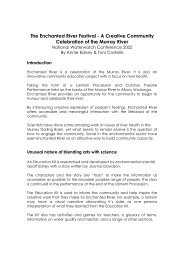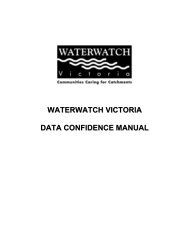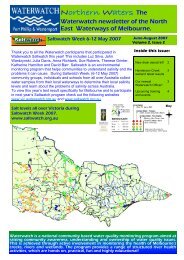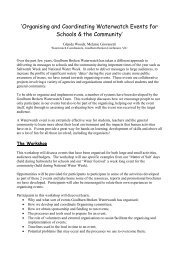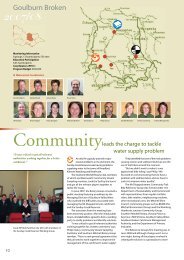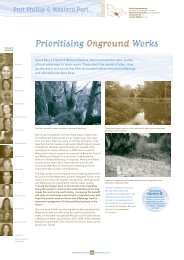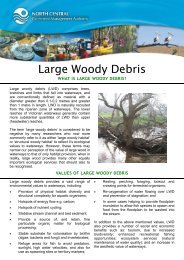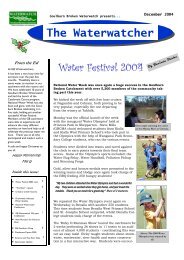West Gippsland Region - Waterwatch Victoria
West Gippsland Region - Waterwatch Victoria
West Gippsland Region - Waterwatch Victoria
You also want an ePaper? Increase the reach of your titles
YUMPU automatically turns print PDFs into web optimized ePapers that Google loves.
Monitoring to plan<br />
Changing land use can put new and<br />
different pressures on waterways.<br />
Stakeholders need to be informed and involved<br />
in suggesting ways to alleviate those pressures.<br />
A year ago, Warragul District Landcare<br />
Group became concerned about the growing<br />
pressure on the network of creeks that run<br />
through the township of Warragul. Known<br />
collectively as Hazel Creek, it is a complex<br />
system of tributaries high up in the upper<br />
catchment of the Moe River that ultimately run<br />
to the sea through Lakes Entrance.<br />
Warragul’s stormwater drainage relies on<br />
Hazel Creek and with increasing urbanisation<br />
around the perimeters of the town, Landcare<br />
was concerned about how the creek system<br />
would handle the effects of new development.<br />
The group began monitoring at five sites<br />
and, by setting up a roster between the 12<br />
monitors, they aim to monitor after rain events.<br />
Assisting their monitoring efforts, the Warragul<br />
Gazette has agreed to publish monthly reports<br />
on the results to help raise community awareness.<br />
The Brooker Park Wetland, situated in the<br />
centre of Warragul, is the key site in the group’s<br />
monitoring program. The data collected<br />
establishes a baseline and shows the effectiveness<br />
of the wetland as a filter and sediment trap and<br />
its role in pollution and flood mitigation.<br />
The group’s data will ultimately inform a<br />
management plan for Hazel Creek, developed<br />
by the <strong>West</strong> <strong>Gippsland</strong> Catchment Management<br />
Authority and Baw Baw Shire Council.<br />
Monitoring results from the groups five sites,<br />
together with other <strong>Waterwatch</strong> data collected<br />
since the early 1990s, will provide valuable<br />
information about where interventions are<br />
needed in order to maintain and hopefully<br />
improve the health of the Creek.<br />
As Liz Clay, a member of the Landcare group<br />
describes, “The wetlands at Brooker Park have<br />
become iconic. By establishing baseline data<br />
our monitoring not only validates the function<br />
of Brooker Park but hopefully will encourage<br />
the development of a system of wetlands.”<br />
A monitoring site on Hazel Creek near the Princes<br />
Highway in Warragul. (Photo: Monica Green)<br />
“The group’s data will ultimately inform a<br />
management plan for Hazel Creek.”<br />
The classroom in a canoe<br />
Year 9 students from Neerim District Secondary<br />
College, monitoring at the water’s edge.<br />
“It is a whole different thing once they’re<br />
on the river. It’s all in context, they can see<br />
what’s around them and they can<br />
understand”<br />
The classroom is not necessarily the<br />
best place to learn a lesson and canny<br />
teachers are changing this tradition to better<br />
engage students.<br />
A few years ago, Neerim District Secondary<br />
College teacher, Liz Keily, participated in a<br />
<strong>Waterwatch</strong> community canoe tour. The tour<br />
sparked an idea for teaching her Year 9 students<br />
an Integrated Studies Unit, based on<br />
environmental studies. Liz thought that by<br />
giving academic issues context, students<br />
would be more interested and engaged and<br />
could better apply what they were learning. So<br />
she literally took the classroom into a canoe!<br />
Every fortnight her students spend a day<br />
paddling different sections of the LaTrobe and<br />
Thomson Rivers. On each trip they undertake a<br />
number of water quality monitoring tests,<br />
habitat and macroinvertebrate assessments<br />
and have representatives from different<br />
organisations talk to them about why the rivers<br />
are important.<br />
Liz said, “You can get people from different<br />
industries to come and talk to the students in<br />
the classroom but it is a whole different thing<br />
once they’re on the river. It’s all in context, they<br />
can see what’s around them and they can<br />
understand.”<br />
Students paddle at the top end of the Lake<br />
Wellington catchment where the river winds<br />
through towering mountain ash forests, down<br />
to low lying irrigated land where agriculture<br />
and the power industry rely on the waterways<br />
for very different needs.<br />
The students have presentations from a<br />
range of stakeholders including farmers,<br />
Landcare, the power industry and the Historical<br />
Society of Walhalla, all who give a different<br />
perspective on the river.<br />
Liz summarizes the experience, “By paddling,<br />
we build up the real story about the river.<br />
<strong>Waterwatch</strong> provides another picture in that<br />
story.”<br />
Partners and Sponsors of the <strong>West</strong> <strong>Gippsland</strong> <strong>Waterwatch</strong> Program Natural Heritage Trust, <strong>West</strong> <strong>Gippsland</strong> Catchment Management Authority, <strong>Gippsland</strong> Water,<br />
South <strong>Gippsland</strong> Water, Southern Rural Water, HVP Plantations, ESSO/BHP Billiton Australia, TRU Energy, Loy Yang Power, SGS Environmental Services.<br />
23



